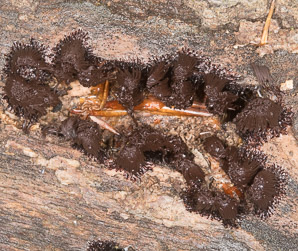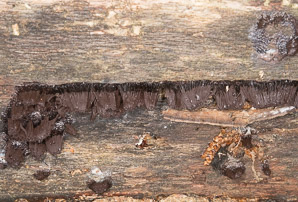
|
Stemonitis spp. Choloate tube slime, tree hair, pipe cleaner slime
Slime molds are often mistaken for fungi. But while fungi extend a network of tiny tendrils through their growth medium (soil, wood, etc.), slime molds stay on the surface, moving slowly to engulf food. Aptly named chocolate tube slime mold takes up residence on damp dead wood. Identification: The slime mold forms densely packed brown tubes ~1/32″ (1-1.5 mm) in diameter and up to ¾″ (2 cm) tall. The brown tubes are called sporangia. Each tube is atop a thin black stalk. They appear on dead wood and leaves from May to October. There are at least 18 species of Stemonitis, but identification is not possible without a microscope or even DNA sequencing. Edibility: Not edible. Not usually poisonous, but if it is growing on your house, it can trigger allergies. Online References:
by Gary Emberger at Messiah College
Stemonitis spp. description by Thomas H. Kent, last updated 24 Aug 2021. © FloraFinder.org. All rights reserved. |
6/18/2017 · Nussdorfer Nature Area, New Ipswich, New Hampshire · ≈ 6 × 4″ (16 × 11 cm) 6/18/2017 · Nussdorfer Nature Area, New Ipswich, New Hampshire · ≈ 6 × 4″ (16 × 11 cm)
|



